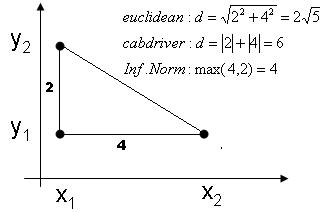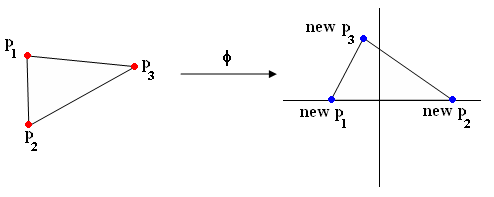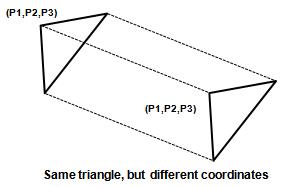| Line 1: | Line 1: | ||
| + | =[[ECE662]], Spring 2008= | ||
| + | =Lecture 1 Lecture notes= | ||
| + | ---- | ||
| + | ---- | ||
'''Nearest Neighbor Classification Rule''' | '''Nearest Neighbor Classification Rule''' | ||
* useful when there are several labels | * useful when there are several labels | ||
| Line 95: | Line 99: | ||
(p1,p2,p3) -> (new p1, new p2, new p3) | (p1,p2,p3) -> (new p1, new p2, new p3) | ||
| − | + | ---- | |
| − | [[Category: | + | [[ECE662:BoutinSpring08_OldKiwi|Back to ECE662 Spring 2008 Prof. Boutin]] |
| + | [[Category:ECE662]] | ||
| + | [[Category:decision theory]] | ||
| + | [[Category:lecture notes]] | ||
| + | [[Category:nearest neighbor]] | ||
Revision as of 13:22, 2 February 2012
ECE662, Spring 2008
Lecture 1 Lecture notes
Nearest Neighbor Classification Rule
- useful when there are several labels
- e.g. fingerprint-based recognition
Problem: Given the labeled training samples: $ \vec{X_1}, \vec{X_2}, \ldots, \vec{X_d} $ $ \in \mathbb{R}^n $ (or some other feature space) and an unlabeled test point $ \vec{X_0} $ $ \in \mathbb{R}^n $.
Classification: Let $ \vec{X_i} $ be the closest training point to $ \vec{X_0} $, then we assign the class of $ \vec{X_i} $ to $ \vec{X_0} $.
What do we mean by closest?
There are many meaning depending on the metric we choose for the feature space.
Definition A "metric" on a space S is a function
$ D: S\times S\rightarrow \mathbb{R} $
that satisfies the following 4 properties:
- Non-negativity $ D(\vec{x_1},\vec{x_2})\geq 0, \forall \vec{x_1},\vec{x_2}\in S $
- Symmetry $ D(\vec{x_1},\vec{x_2})=D(\vec{x_2},\vec{x_1}), \forall \vec{x_1},\vec{x_2}\in S $
- Reflexivity $ D(\vec{x},\vec{x})=0, \forall \vec{x}\in S $
- Triangle Inequality $ D(\vec{x_1},\vec{x_2})+D(\vec{x_2},\vec{x_3})\geq D(\vec{x_1},\vec{x_3}) , \forall \vec{x_1}, \vec{x_2}, \vec{x_3}\in S $
 Illustration of 3 different metrics
Illustration of 3 different metrics
Examples of metrics
Euclidean distance: $ D(\vec{x_1},\vec{x_2})=||\vec{x_1}-\vec{x_2}||_{L_2}=\sqrt{\sum_{i=1}^n ({x_1}^i-{x_2}^i)^2} $
Manhattan (cab driver) distance: $ D(\vec{x_1},\vec{x_2})=||\vec{x_1}-\vec{x_2}||_{L_1}=\sum_{i=1}^n |{x_1}^i-{x_2}^i| $
Minkowski metric: $ D(\vec{x_1},\vec{x_2})=||\vec{x_1}-\vec{x_2}||_{L_p}=(\sum_{i=1}^n ({x_1}^i-{x_2}^i)^p)^{\frac{1}{p}} $
Riemannian metric: $ D(\vec{x_1},\vec{x_2})=\sqrt{(\vec{x_1}-\vec{x_2})^\top \mathbb{M}(\vec{x_1}-\vec{x_2})} $
Infinite norm: $ D(\vec{x_1},\vec{x_2})=||\vec{x_1}-\vec{x_2}||_{\infty}=max_i |{x_1}^i-{x_2}^i| $
where M is a symmetric positive definite $ n\times n $ matrix. Different choices for M enable associating different weights with different components.
In this way, we see that $ \mathbb{R}^n $, $ \mathbb{Z}^n $, $ \mathbb{C}^n $ have many natural metrics, but feature could be in some other set, e.g. a discrete set.
for example,
$ x_1 $={fever, skinrash, high blodd pressure}
$ x_2 $={fever, neckstiffness}
Tanimoto metric
$ D(set1, set2) = \frac {|set1|+|set2|-2|set1 \bigcap set2| }{|set1|+|set2|-|set1 \bigcap set2|} $
Example: previous approach to shape recognition Given is a set of ordered points in $ R_n =(p_1,p_2,\cdots,p_N) $ We want to recognize the shape
Given template (triangle form): (T1,T2,...,TN); We want to assign one of test template to a test (P1,P2,P3) In this case, we should not use Euclidean distance!,
becasue shape defined by point is unchanged (invariant) by rotation and translation of triangles.
Therefore, distance between 2 triangles (or shapes) must be independent on the position and orientation of triangles.
Procrustes metric
$ D(p,\bar p)= \sum_{\begin{matrix}i=1 \\ rotation R, translation T \end{matrix}}^n {\begin{Vmatrix} Rp_i+T-\bar p_i \end{Vmatrix}} _{L^2} $
$ p=(p_1, p_2, \cdots ,p_N),\bar p = (\bar p_1, \bar p_2, \cdots ,\bar p_N) $
Alternative approach "Use invariant coordinate to repeat $ p=(p_1, p_2, \cdots ,p_N) $ "
i.e find $ \varphi $ such that
$ \varphi : \mathbb{R}^n\rightarrow \mathbb{R}^k $ (where, typically $ k \leq n $)
s.t $ \varphi (x) = \varphi (\bar x) $
whenever $ \exists $ R, T with $ R \bar X + \bar T = X $
Example of phi with triangle (Figure 3):

(p1,p2,p3) -> (new p1, new p2, new p3)



